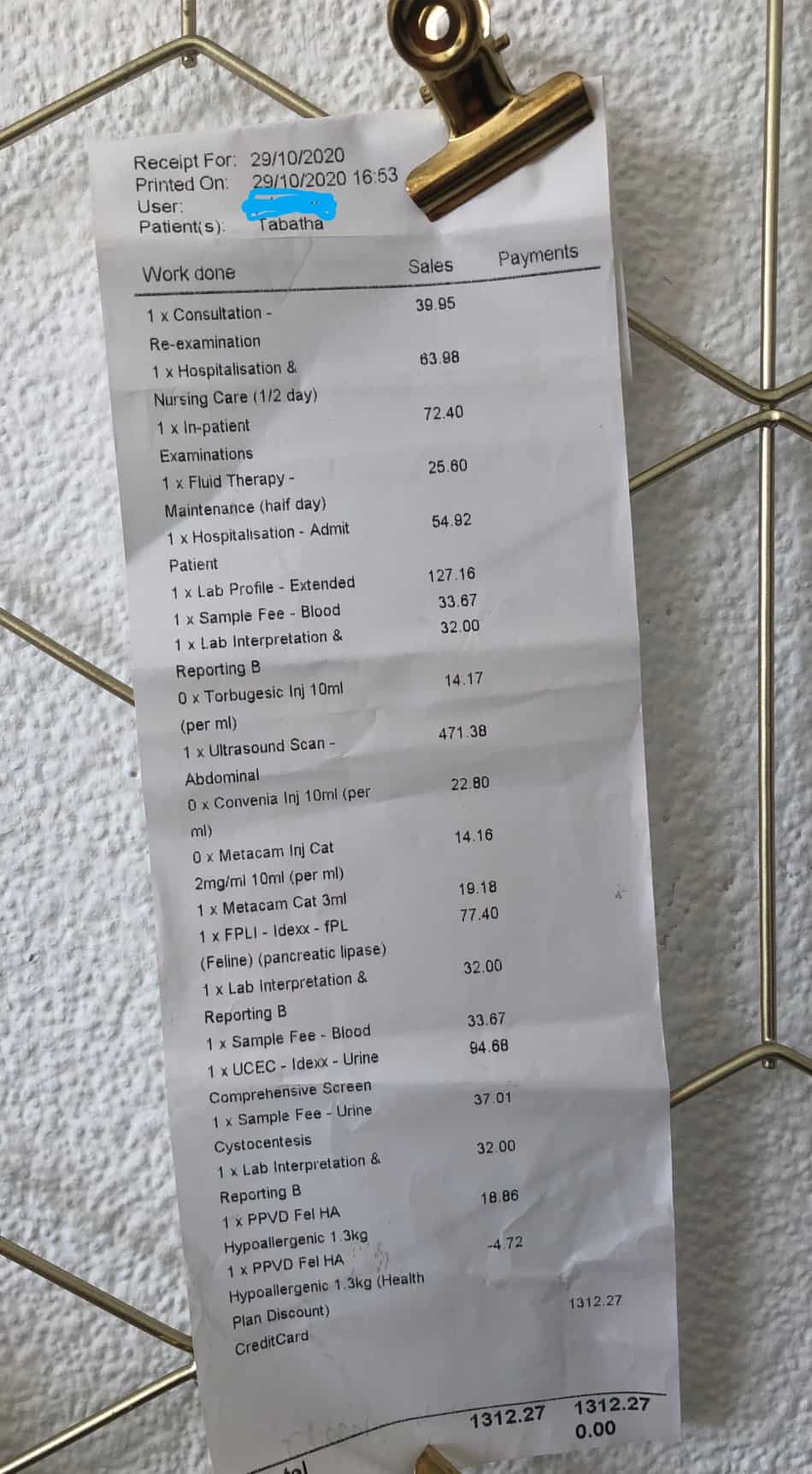I wanted to write about something that terrified me in October 2020, a period of 72 hours. It resulted in an unexpected euthanasia chat by the vet, lots of tests, emotions of nightmare proportions, sitting by the phone, feeling numb and knowing I have one frightened, poorly elderly cat in hospital. And when your vet mentions euthanasia three times, as a last resort, well, it dawns on you that your 14-year cat, with you since a kitten, may not be by your side by the weekend is surreal.
Different scenarios went through my head, including making myself accept the worst should it happen. Well, I tried—the feeling of pending loss was horrid. I was at a village veterinary appointment one minute and then suddenly travelling across a city to take Tabitha to the veterinary hospital. For starters, she needed fluids and would be placed on a drip. Euthanasia kept going through my head. That word instils a severe kick and fears deep in the pit of your stomach. My head felt like fog. I pleaded with God to let her be okay.
Any devoted animal owner will understand.
How I rescued my shy LaPerm cat and discovered she was seriously ill

I brought Tabitha home when she was just 6 months old from a breeder. I know some people might raise an eyebrow, but sometimes even pedigrees need a little rescuing. The breeder focused on cats meant for shows, and Tabitha, a beautiful brown La Perm with curly fur, didn’t quite fit the bill.
Her curls have softened over time from all the love and attention she gets, but even back then, she was incredibly shy, making her unsuitable for shows. So, I was lucky enough to bring her home for just £25.
But I discovered she was a very ill cat.
About the LaPerm cat breed

Tabitha in 2018
The LaPerm breed originally comes from America, and despite their gorgeous and fancy appearance, they started as hardworking farm cats. They were all about freedom, interbreeding, and keeping mice and rats in check—doing whatever it took!
In 1982, in Oregon, a rex cat named Curly made history by giving birth to kittens with curly ringlets, thanks to a dominant rex gene. This unique look inspired the name of the breed: LaPerm – because they do look like they’ve had a perm!
Here’s a tip: when grooming your LaPerm, use a toothed comb instead of a brush, as a brush can straighten those lovely curls.
Like other LaPerms, Tabitha has a lioness-like face, a distinctive shoulder structure, a fluffy ‘fox-like’ tail, and fur that flares out on her hind legs, which I affectionately called her pantaloons!
According to the LaPerm Club, these cats are generally healthy, but I’ve found that’s not always the case—Tabitha developed some health issues.
The character of a LaPerm:
- Playful
- Energetic
- Inquisitive
- Bold
- Friendly
- Purrs loudly when fussed
- You make you understand when being ignored
- Attention and cuddles
- Gives you gifts
In 2001 / 2002, Anthony Nichols imported the first LaPerm into the UK. I sometimes wonder if Tabitha is related to this first cat.
How spaying helped resolve my LaPerm cat’s persistent diarrhoea and weight loss
Around 2007, I happened to meet another LaPerm owner who mentioned that her cat also had persistent diarrhoea, just like Tabitha. She said her friend’s LaPerm had the same issue and suggested it might be related to their “lady bits,” recommending that I get Tabitha spayed.
That same year, 2007, Tabitha started losing weight rapidly, and her stools were like water. I had to cover my floors with polythene, put her on a sensitive diet, and even booked a biopsy because nothing was helping. After chatting with the other LaPerm owner, I decided to book Tabitha in for spaying too. Thankfully, her weight was stable enough for the anaesthesia, so in April 2007, she was spayed. That very evening, she came home acting like a kitten again—racing around, eating, and, most importantly, the diarrhoea stopped! I tossed out the polythene and cancelled the biopsy.
Was it an issue with her lady bits? I’ll never know for sure, but I’m just glad she’s healthy now!
How to help a cat with stress: tips and remedies
By the summer of 2019, Tabitha’s stress levels started to rise, especially after Molly, my 20-year-old cat, passed away. She displayed stress by overgrooming and pulling out huge chunks of her fur. By February 2020, she had lost weight, and by March, she had pulled out half her body fur. We made several trips to the vet, but when the first Covid-19 lockdown hit, I tried using Rescue Remedy spray. The valerian scent seemed to help calm her down, and being on furlough meant I was home with her all spring and summer.
Of course, calming products can help but if a medical issue, it needs to be addressed.
The following are calming products I have successfully used with different cats:
- Pet Remedy spray – for cats, dogs, birds, horses, mammals, reptiles
- Pet Remedy wipes
- Zyklene – powder capsules that can be mixed with food
You can read my article: 3 Products for Stress & Cystitis for more in-depth information
I also noticed she started dragging her bum on the floor after using the litter box, and developed diarrhoea and vomiting again, along with some discomfort when trying to toilet. With veterinary practices running on limited staff, getting her an appointment during the late summer of 2020 was tough. Her August Pet Health Care check-up was cancelled, but I finally got her a paid consultation in September. I made sure to keep a notebook to track her health and give the vet a full update without missing any details.
By the way, if you need to raise money for pet care, please read my article to raise money for vet bills. These are based on how I top up the veterinary account.
Navigating a stressful vet Visit During Covid-19: Tabitha’s geriatric screening and cystitis concerns

On September 18th, Tabitha had a vet appointment. Due to the Covid-19 restrictions, I wasn’t allowed in the consultation room and had to wait in the waiting area with a facemask on. During the visit, Tabitha had a geriatric screening and needed a urine sample taken. Since she refused to urinate when the vet tried to express her bladder, they had to use a needle to collect the urine. The needle goes through the abdominal wall into the bladder, and hearing Tabitha cry terrified and upset me.
The total cost of the appointment was £220, including the £45 consultation fee and £74.16 for the geriatric screening. While I was waiting to pay, poor Tabitha vomited in her carrier from the stress.
Before sending the urine to the lab, the vet mentioned they found traces of blood in it, likely due to cystitis, which can be brought on by stress. The vet recommended that Tabitha eat two cans of wet food a day to stay hydrated, drink plenty of water, and temporarily cut back on dry food.
The results of the test:
- Liver, thyroid and kidney in the normal ranges
- Possible cystitis
- No infection in the urine
I eventually started giving Tabitha a calming supplement called Zylkene, which is a powder you can mix into food or cat/dog sauce. It contains a natural ingredient that helps pets relax. I’ve also tried other calming products at home, which you can read about in the linked article.
If you’re thinking about collecting a urine sample at home, check out my video on using Katkor. This product is great for stressed cats since it helps you avoid a trip to the vet. I took Tabitha’s urine sample to the vet for testing, and the results came back clear—no cystitis. However, the vet did give her an extra dose of Milbemax as a precaution, just in case of tapeworm.
Addressing Tabitha’s October health scare: Toileting issues, weight loss, and emergency vet care

In October, Tabitha started having toileting issues again. She let me know she was in pain by urinating on the bedroom floor and bed. The amount of blood in her urine really scared me. She kept going back and forth to her litter tray but couldn’t actually pee. She did the same outside, moving to different spots in the garden. I think she was associating the litter tray and various areas in the garden with pain, so she kept trying different places. If you notice your cat doing something similar, don’t panic—there could be many reasons for it, but it’s always best to consult a vet if you’re worried.
When I took Tabitha to the vet, they told me she was dehydrated and had lost too much weight since her last visit—she was down to 2.88 kg, having lost 120 g. Hearing that felt like a sledgehammer to the chest.
Within 15 minutes, I was driving across Hull to a veterinary hospital, feeling numb and scared, just like any pet owner would in an emergency. Tabitha needed more tests and had to stay overnight so the veterinary surgeon could dig deeper into what was going on. Otherwise, her weight loss could mean euthanasia.
I want to thank both vets for keeping in touch with me that evening and several times the next day.
At the hospital, Tabitha was sedated for an ultrasound, had her blood tested, and more urine samples were taken. She was also given fluids intravenously, which helped bring her weight up to 3 kg. Unfortunately, she refused to eat, drink, or use the toilet, which is usually a bad sign in animals. I insisted to her vet that she was just scared and in an unfamiliar place—she wasn’t ready to be put to sleep.
As for the test results: they found that the walls of her intestines had thickened. The small intestine is responsible for digestion, while the large one handles waste, so they considered gastro issues. The good news was that her spleen, liver, pancreas, and kidneys were all okay, and there were no stones or masses in her bladder.
Tabitha’s vet recommended further tests:
- Blood test for the pancreas
- Then a biopsy
- Lymph samples from the gut
- The anti-biotic injection that lasts 2 weeks
- Cytology, so the urine goes under the microscope to assess the floaters
- Metacam for the inflammation but stop at any sign of diarrhoea
- Hypoallergenic food
I opted for the blood test for Tabitha’s pancreas, cytology, and some antibiotics, but I was really concerned about putting her through more stress with additional jabs, prodding, and sedation. So, I decided to wait for these test results before making any further decisions.
The good news was that her pancreas was normal, and the cytology showed no cancer cells in her bladder. However, her urine was abnormal with blood clots, which could have been due to the fluids she received at the hospital. There were no infections, but the inflammation might be stress-related, and the blood in her urine could be from cystitis. The thickening of her intestinal walls could be due to an allergy or cancer. It was also possible she was dragging her bum because it was inflamed. The vet suggested trying hypoallergenic and anallergenic food first.
The bill came to £1,312.
Why is a vet suggesting euthanasia?
I’ve read so many posts where vets tell owners that their pets might need to be put to sleep, but then the owner works closely with their pet, and it works out—their pet is still with them today.
Vets have a moral responsibility to mention euthanasia to prevent suffering. I’m grateful to my vets for recommending specialised food first, but I understood they had to say that it wouldn’t be fair to keep Tabitha alive if she continued losing weight. Each time they mentioned it, it filled me with fear. That first whole day Tabitha was in the hospital, I just sat by the phone, telling myself she might come home for a night or two, and then I’d have to say goodbye. Then I’d swing to denial, questioning how this could all happen so suddenly. I cried so much.
I’m sure many of you have been there too.
Can a hypoallergenic diet help an animal?
When Tabitha came home from the veterinary hospital, the very first thing she did was head straight to her food station and eat—I knew she would!
I followed the vet’s instructions and gradually switched her from her regular food to hypoallergenic food. By the way, I learned from my vet that sensitive food is different from hypoallergenic and anallergenic food.
Tanitha’s diet:
- Royal Canin hypoallergenic dry biscuits which she started eating then refused
- Royal Canin anallergenic dry biscuits – Tabitha loves this one
- Purina Veterinary Diet Feline HA Hypoallergenic *** Tabitha wasn’t keen on this brand
- Pets at Home Wainwright
Since Tabitha is enrolled in the Pet Health Care scheme, I received a discount on her treatments.
On December 1st, 2020, Tabitha weighed 3.15 kg. I use baby scales at home, and the vet asked me to weigh her right after we got back from the hospital to compare my scales with theirs. Turns out, there’s no difference!
Tabitha continued to drink a lot of water, and I gave her one dose of Metacam. The vet advised me to stop the medication if she developed diarrhoea, so when that happened, I immediately stopped it. Now, her diet consists only of Royal Canin and Purina, and she really enjoys those biscuits!
How you can help your cat’s cystitis at home
Watch the Video: See how easy it is to use Feliway Cystease at home. If you enjoy the mini-film, please support my channel by liking it and subscribing to Poppy’s Pets!
I started giving Tabitha Feliway Cystease in December 2020, and whenever I noticed her getting anxious around the house, I gave her another dose. The results were beneficial —Cystease calmed Tabitha and stopped the cystitis.
My girl turned 15 in the summer of 2021. When the vet mentioned that the bladder floaters might be cancer, I decided to let the illness run its course, given her age and stress levels. However, the thickening of her intestine walls might be due to food allergies. Changing her diet has helped her gain weight and reduced her soft, runny stools. As of March 2021, her weight increased to 3.26 kg.
Tabitha never had cancer.
Disclaimer
Poppy’s Pets does not give medical advice. I advise that if you have concerns about your pet, you must visit a qualified veterinary surgeon for a pet assessment, discussion and medical advice. I recommend an initial consultation with your pet’s vet because the inability to urinate may be from more serious factors.
Poppys Pets is a participant in Awin and Amazon Associate affiliate programs which compensates me for referring traffic. It is of no extra cost to you and if thinking of buying a product, please consider using my link. It\'ll earn Poppy\'s Pets a few pennies to continue to this website. Only a selection of articles and videos on this website and YouTube channel contains affiliate links. Further information: Disclaimer and Privacy Policy

